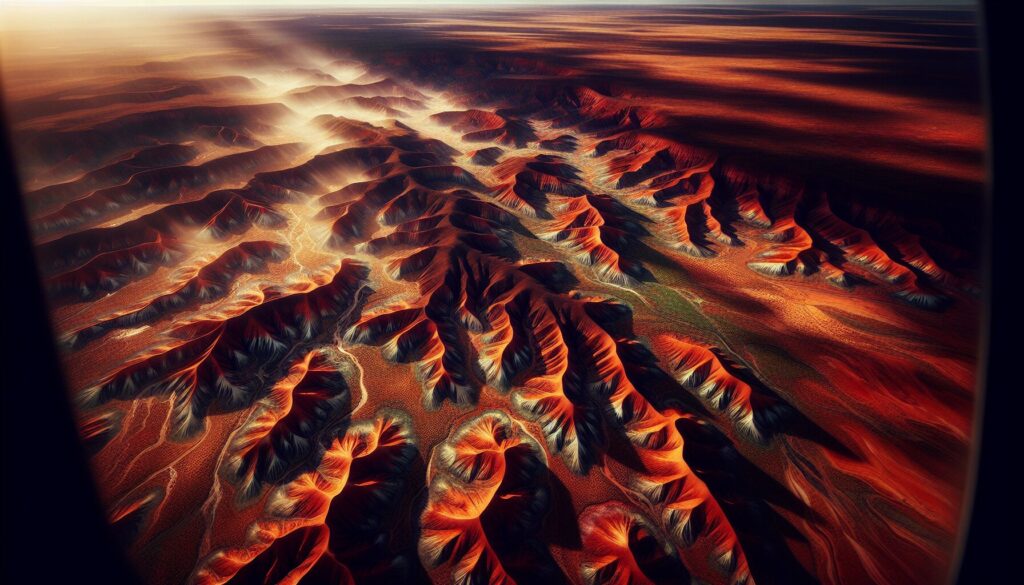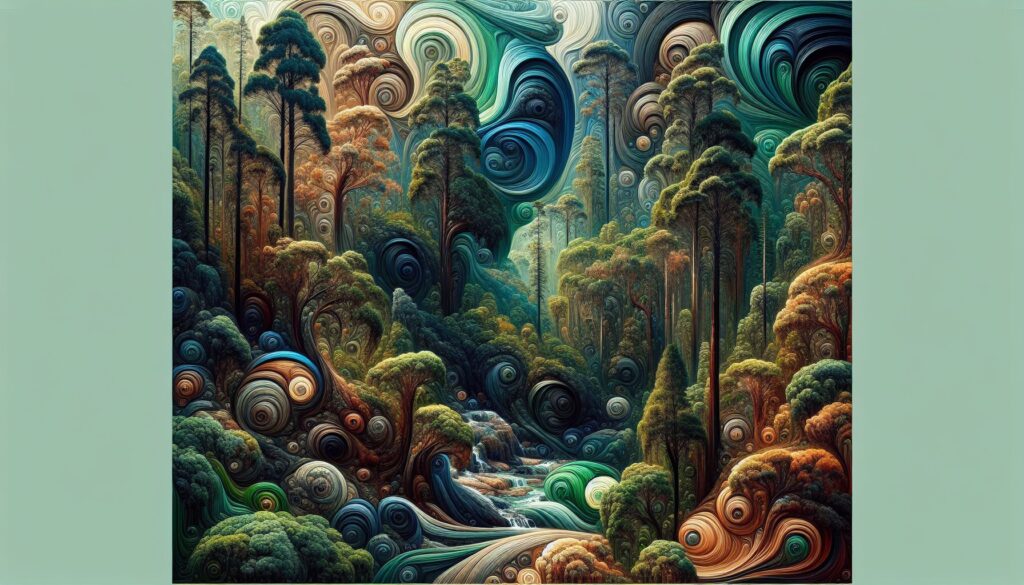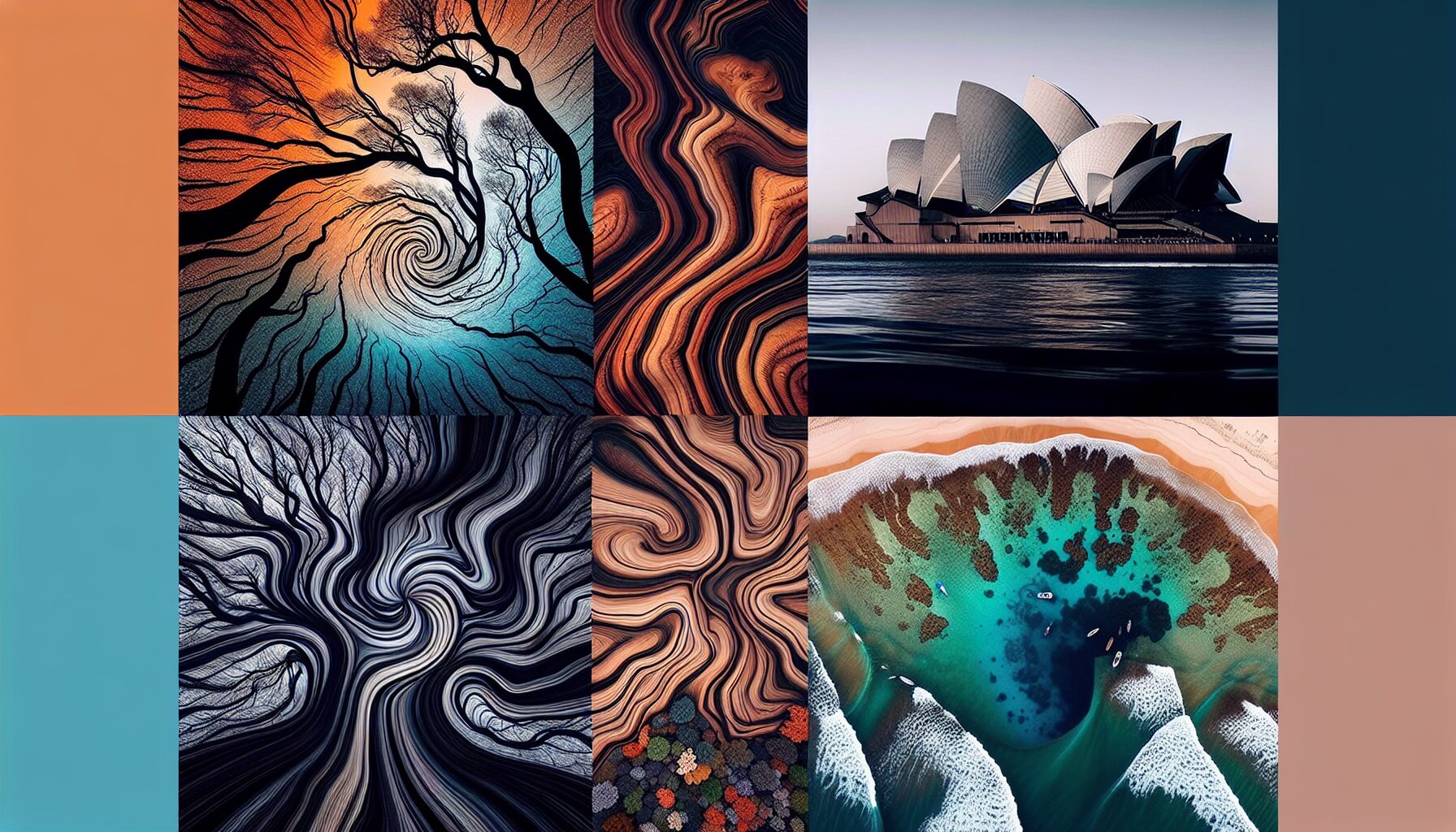Australia’s vast landscapes and unique natural formations make it a haven for abstract photographers. Its diverse environments, from coastal lines to arid deserts, offer opportunities to experiment with textures and colors. I remember capturing the striking patterns of Uluru with my Canon EOS R5. Using a 50mm f/1.8 lens, I set my camera to ISO 100, f/16, and a shutter speed of 1/30s. The result was mesmerizing, with the red rock contrasting against the deep blue sky. Additionally, using a polarizing filter helped enhance the colors and suppress glare, making the details pop. Abstract photography in Australia allows creativity to flourish. Places like the Great Barrier Reef and the Daintree Rainforest also offer vibrant palettes. These locations provide endless inspiration. Organizations such as `Australian Photography Society` often host workshops and events, making it easier to explore these incredible spots.
Related: The Ultimate Guide to Abstract Photography
The Allure of Australia's Unique Landscapes
Australia’s diverse landscapes offer endless opportunities for abstract photography. From the vibrant hues of the Great Barrier Reef to the stark contrasts of the Outback, each setting can transform a simple photo into a work of art. When I visited the Pinnacles Desert in Western Australia, I was amazed by the alien-like limestone formations. Using my Canon EOS R5 with a 24-70mm f/2.8 lens, I captured the scene with an ISO of 100, f/16, and a shutter speed of 1/60s. The low ISO ensured minimal noise, while the narrow aperture provided sharpness throughout the image.
Moreover, the intense sunlight created dramatic shadows, enhancing the abstract quality of the photos. By experimenting with angles and perspectives, the landscape’s natural patterns became more pronounced. A polarizing filter helped reduce glare and deepen the sky’s blue, adding depth to the images. For those with a keen eye for detail, the textures of the Outback’s red earth offer another layer of intrigue. The interplay of light and shadow can be mesmerizing.
Exploring Coastal Wonders
Australia’s coastline is equally captivating for abstract photography. The Twelve Apostles, located along the Great Ocean Road, provide a stunning backdrop. During sunrise or sunset, the limestone stacks are bathed in golden light. This creates a warm and ethereal atmosphere. With my Nikon D850 and a 50mm f/1.8 lens, I focused on capturing the reflections in the water. This approach highlighted the contrast between the ocean’s movement and the static rock formations. A slow shutter speed of 1/15s added a sense of motion, blurring the waves while keeping the Apostles sharp.
Furthermore, the coastal cliffs near Byron Bay offer another unique setting. The rugged terrain and crashing waves present endless possibilities for creative compositions. By adjusting the camera settings and experimenting with different lenses, photographers can uncover new dimensions in familiar landscapes. Whether you’re photographing the arid deserts or the dynamic coastlines, Australia’s natural beauty provides an unparalleled canvas for abstract photography enthusiasts. For more information on these breathtaking locations, consider visiting resources like Tourism Australia and Parks Australia to assist in planning your photographic journey.
Spot 1: Hidden Gems in the Outback

Australia’s Outback offers some of the most unique abstract photography opportunities. One hidden gem for photographers is the Painted Desert. This area, with its vibrant colors and layered rock formations, is a dream for those seeking abstract imagery. When I visited, I used my Canon EOS R5, paired with a 24-70mm f/2.8 lens. The versatility of this lens allowed me to capture both wide landscapes and detailed textures. I set the camera to ISO 100 to minimize noise and used an aperture of f/16 to ensure a deep depth of field. This helped me capture the intricate details of the rock layers.
Moreover, the early morning light creates stunning contrasts, making the colors even more vivid. A polarizing filter can enhance these effects, reducing glare and increasing color saturation. While photographing, I also experimented with long exposures, setting the shutter speed to 1/30s. This technique emphasized the smooth lines of the landscape, transforming them into abstract forms.
Exploring Coober Pedy
Another noteworthy spot is Coober Pedy, known for its opal mines. The town’s unique underground homes and landscapes provide endless abstract compositions. Utilizing a drone here can offer a fresh perspective, capturing the surreal patterns from above. According to Tourism Australia, Coober Pedy is home to over 70% of the world’s opal production, adding a unique element to your photographs.
Additionally, the vibrant sunsets in the Outback create dramatic silhouettes. The stark contrast between the darkened foreground and the fiery sky adds a layer of abstraction. A tripod is essential for these low-light conditions, ensuring sharp images without camera shake. Planning your visit around the weather can also yield different abstract effects, as storms introduce dramatic lighting and reflections. Whether it’s the earthy reds of the Painted Desert or the opalescent hues of Coober Pedy, the Outback is a treasure trove of abstract photography opportunities.
Spot 2: Coastal Wonders and Abstract Visions
Australia’s coastlines offer mesmerizing scenes for abstract photographers. One of my favorite spots is the Great Ocean Road in Victoria. The interplay of dramatic cliffs and the Southern Ocean creates stunning patterns and textures. When I last visited, I used my Canon EOS R5 with a 24-70mm f/2.8 lens. This allowed me to capture close-up shots of the rock formations. I set the ISO to 100 and used an aperture of f/16 to ensure sharp images. The long exposure technique, with a shutter speed of 1/30s, blurred the waves beautifully.
Additionally, using a polarizing filter can enhance the colors and reduce reflections. This is particularly useful when shooting near water. The vibrant hues and contrasting shadows offer endless possibilities for creating abstract art. Another exceptional location is Bondi Beach in Sydney. Renowned for its sweeping curves and dynamic waves, it’s a playground for photographers. I recommend visiting during the golden hour for the best lighting conditions.
Exploring Unique Coastal Patterns
However, don’t miss out on the lesser-known beaches like Hyams Beach in New South Wales. Known for its incredibly white sand, it provides a stark contrast against the turquoise waters. A macro lens is ideal here to capture the intricate details of the sand granules. Furthermore, the nearby Jervis Bay is perfect for night photography enthusiasts. The bioluminescent plankton creates a surreal glow at night. For the best results, consider learning more about infrared photography techniques.
Lastly, Western Australia’s Cable Beach offers a wide expanse of pristine sands. The low tide reveals fascinating patterns and textures on the sand. I recommend a drone for capturing aerial shots of this breathtaking landscape. Keep an eye on the tides and weather conditions for optimal shooting opportunities. For more local insights, you might contact the Tourism Australia for tips and guided tours to these abstract photography spots.
Spot 3: Urban Abstracts in Major Cities
Australia’s major cities are treasure troves for urban abstract photography. Each city offers a unique canvas of geometric shapes, vibrant colors, and intriguing textures. Sydney, for instance, boasts the stunning architecture of the Sydney Opera House. Its sails create fascinating shadows and lines, perfect for capturing abstract images. When I visited, I used my Canon EOS R5 with a 24-70mm f/2.8 lens. Setting the ISO to 100 and using a polarizing filter helped emphasize the contrast between the bright white sails and the sky.
Melbourne’s laneways present a different kind of abstract beauty. The street art and graffiti provide a colorful backdrop full of potential. I once explored Hosier Lane with a 50mm f/1.8 lens. The wide aperture allowed me to isolate parts of the artwork, creating an abstract effect. The textures of layered paint and brickwork were accentuated by shooting at f/4 to maintain some depth of field. Be sure to visit these spots early, as the morning light brings out the colors magnificently.
Brisbane’s Modern Marvels
Brisbane, meanwhile, offers a more modern setting. The Brisbane City Hall and its surrounding skyscrapers are perfect for capturing reflections and symmetry. On a sunny day, the glass facades mirror the blue sky, creating abstract patterns. Using a tripod, I set my camera to f/16 and 1/30s to achieve sharpness throughout the frame. This technique highlighted the intricate details of each building’s design.
Incorporating these techniques can help you capture the unique essence of Australia’s urban landscapes. Each city offers endless possibilities for abstract photography, providing an opportunity to see beyond the ordinary.
Spot 4: Forests and Nature's Abstract Canvas

Australia’s forests are a treasure trove for abstract photography enthusiasts. The interplay of light and shadow in these dense woodlands creates stunning visuals. I remember my first visit to the Daintree Rainforest. Armed with my Canon EOS R5 and a 50mm f/1.8 lens, I was eager to capture the ethereal beauty. Setting my ISO to 800, aperture to f/2.8, and shutter speed to 1/60s, I was able to photograph the intricate patterns of sunlight filtering through the leaves. Using a polarizing filter, I enhanced the vibrant greens and reduced glare, adding depth to each shot.
Moreover, the textures found in these natural settings are unparalleled. The bark of eucalyptus trees, for example, provides unique abstract patterns. By employing the technique of macro photography with a 100mm lens, one can capture these details with precision. I adjusted my camera settings to ISO 200, f/11, and a shutter speed of 1/200s to ensure crisp images. The resulting photos were a testament to nature’s artistry.
Exploring Different Forests
In addition to the Daintree, the Blue Mountains offer a different perspective. Here, mist often envelops the forest, creating dreamlike conditions. Using a wide-angle lens, such as a 24-70mm, you can capture the vastness and mystery of these landscapes. Setting the aperture to f/14 and ISO to 400, I captured the soft fog embracing the trees. The Blue Mountains National Park is a must-visit for anyone looking to explore Australia’s abstract photography spots.
For those interested in unique subjects, the Royal Botanic Gardens Victoria offers an array of plant life. The interplay of colors and shapes provides endless opportunities for abstract compositions. Utilizing a tripod for stability, I experimented with long exposures to capture the movement of leaves in the wind. This technique, combined with a neutral density filter, allowed for stunning motion blur effects. Australia’s forests truly are nature’s abstract canvas, offering endless inspiration for photographers.
Spot 5: Desert Dreams and Surreal Scenes
Australia’s expansive deserts offer a paradise for abstract photography enthusiasts. Imagine the vibrant red sands of the Simpson Desert or the unique rock formations of the Pinnacles Desert. Each location presents a surreal scene waiting to be captured. I remember my first visit to the Pinnacles, armed with a Canon EOS R5 and a 50mm f/1.8 lens. The clarity of the rocks against the sky was mesmerizing. I set the ISO to 100, aperture to f/16, and used a shutter speed of 1/30s. This combination perfectly captured the vivid colors and stark contrasts.
Additionally, the use of a polarizing filter helped reduce glare and enhance the depth of the sky. This technique is vital when shooting in harsh sunlight. The desert’s natural formations are ideal for experimenting with shadows and light, creating abstract imagery that feels otherworldly. Furthermore, sunrise and sunset offer magical lighting conditions, casting long shadows that add drama to your shots.
Chasing Light and Shadows
Beyond the Pinnacles, Australia’s deserts like the Red Centre in the Northern Territory offer endless opportunities. The changing light throughout the day creates dynamic landscapes. Using a tripod is essential for stability, especially during long exposure shots. I once captured the mystical Uluru at dusk, utilizing a wide-angle lens to encompass the vastness. The rock’s changing hues as the sun set were breathtaking. For those interested in these unique locations, resources like Tourism Australia offer detailed guides.
Moreover, joining a local photography tour can provide insights into the best spots and times for shooting. These tours often include visits to lesser-known areas, offering fresh perspectives. With the right techniques and equipment, Australia’s desert landscapes transform into a canvas of abstract beauty. Every detail, from the play of light to the texture of the sand, contributes to a stunning shot.
Conclusion
To sum up, Australia’s diverse and breathtaking landscapes provide a rich tapestry for abstract photographers. From the vibrant hues of the Great Barrier Reef to the stark beauty of the Outback and the dynamic coastlines, each location offers unique opportunities to experiment with textures, colors, and light. The use of various camera techniques and equipment, such as polarizing filters and long exposures, can help capture the essence of these natural wonders. Additionally, exploring urban settings and lush forests adds another dimension to abstract photography, revealing hidden gems in both cityscapes and nature. Whether you’re drawn to the surreal scenes of the desert or the intricate patterns of the forest, Australia’s beauty promises endless inspiration for photographers seeking to push the boundaries of creativity. Happy shooting!
Continue Exploring
Unlock the mysteries of abstract photography and elevate your artistic skills. Dive into techniques that transform the ordinary into the extraordinary.
Frequently Asked Questions
What are some unique locations for abstract photography in Australia?
Australia offers a plethora of unique locations for abstract photography, including the surreal landscapes of the Pinnacles Desert in Western Australia, the striking colors of the Painted Desert in South Australia, and the dramatic rock formations of the Bungle Bungles in Purnululu National Park. These spots provide photographers with a canvas of natural textures and colors perfect for abstract compositions.
How can I capture stunning abstract photos in Australian national parks?
To capture stunning abstract photos in Australian national parks, focus on details such as patterns, textures, and colors found in nature. Experiment with different angles and lighting conditions, and consider using macro photography to highlight intricate details. Locations like Kakadu National Park and the Blue Mountains offer diverse environments that are ideal for abstract photography.
Which Australian urban locations are best for abstract photography?
For abstract photography in urban settings, Australian cities like Melbourne and Sydney offer a wealth of opportunities. In Melbourne, explore the vibrant street art and modern architecture of the city’s laneways. In Sydney, the Sydney Opera House and the Harbour Bridge provide iconic structures with unique shapes and lines that are perfect for abstract compositions.


Leave a Reply